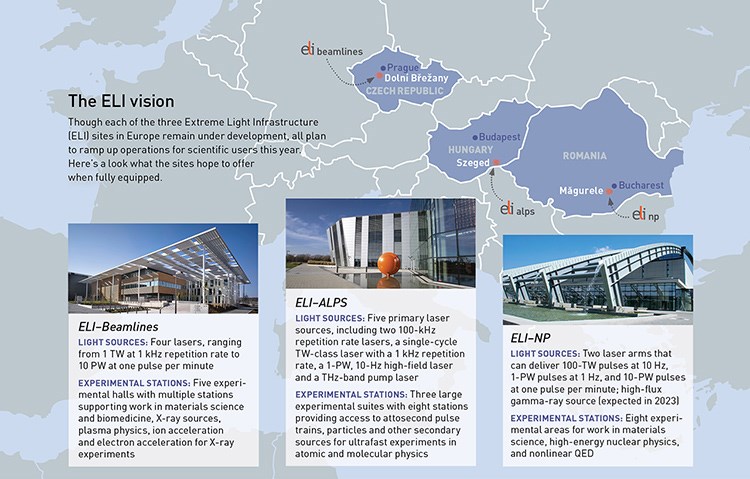 |
| High power Laser System (HPLS) panoramic view of the 40 m-70 m clean room at ELI-NP site. |
Yesterday, August 19th, 2020, Professor Ioan Dancus, Head of Laser Systems Department at Extreme Light Infrastructure-Nuclear Physics (ELI-NP) posted an amazing news in his LinkedIn page:
“The first 10 PW laser pulse was shot today at 14:37 through the ELI-NP laser beam transport system during an endurance test! During the one hour test we have shot 10 pulses at 3 PW, 10 pulses at 7 PW, 3 pulses at 8 PW and 10 pulses at 10 PW, showing the robustness of the ELI-NP laser system.
This is the result of a great collaboration between ELI NP Magurele and Thales.”
The test was performed in the presence of Prof. Gerard Mourou (Nobel Prize in Physics 2018 and initiator of the ELI infrastructure) and officialities from the Romanian Government and the other ELI pillars that participated through teleconference. This achievement is the result of a great collaboration between Thales and ELI-NP teams and proves once more the quality of the ELI-NP implementation.
A laser one-tenth of the sun’s power on Earth officially debuted in March when researchers in Romania ran the first successful test at 10 petawatts (PW). The laser is one of three in an international project in Europe known as Extreme Light Infrastructure. To date, it is the most powerful laser ever built, and it’s the most concentrated power on the planet. It’s hard to overstate the enormity of 10PW, which equates to 10 million billion watts. As a point of comparison, laser pointers sold in market are limited to being at most 0.005-watt for safety.
 |
| The team at ELI-NP working on 10PW laser. Published by Prof. Dancus |
Extreme Light Infrastructure-Nuclear Physics (ELI-NP)
The laser in question is part of the Extreme Light Infrastructure (ELI) project, an effort started by scientists in Europe in the mid-2000s and led by French scientist and Nobel Prize winner Gérard Mourou. The European Strategic Forum for Research Infrastructures (ESFRI) has selected in 2006 a proposal based on ultra-intense laser fields with intensities reaching up to 1022-1023 W/cm2 called \ELI” for Extreme Light Infrastructure. The construction of a large-scale laser-centered, distributed pan-European research infrastructure, involving beyond the state-of-the-art ultra-short and ultra-intense laser technologies, received the approval for funding in 2011-2012.
“It represents a jump of a factor of 10 over what had been demonstrated when the project began. It was a real challenge for Thales and Romania. A “Moon Landing” without the possibility of failing. For me, I stopped breathing for the past two years. Hats off to Thales, hats off to Romania. Congratulations and thank you because now the scientific community will be able to use this magnificent instrument ”.
Professor Gérard Mourou, Nobel Prize in Physics 2018 and initiator of the ELI infrastructure.
The facility will be based on four sites. Three of them are presently being implemented in the Czech Republic, Hungary and Romania, with an investment volume exceeding €850 million, mostly stemming from the European Regional Development Fund (ERDF). The Romanian pillar is ELI-Nuclear Physics (ELI-NP). The new facility is intended to serve a broad national, European and International science community. Its mission covers scientific research at the frontier of knowledge involving two domains. The first one is laser-driven experiments related to
nuclear physics, strong- field quantum electrodynamics and associated vacuum effects. The second is based on a Compton back-scattering high-brilliance and intense low-energy gamma beam (< 20 MeV), a marriage of laser and accelerator technology which will allow us to investigate nuclear structure and reactions as well as nuclear astrophysics with unprecedented resolution and accuracy.
In addition to fundamental themes, a large number of applications with significant societal impact are being developed. The ELI-NP research center will be located in Măgurele, not far from the capital city Bucharest. The project is implemented by “Horia Hulubei” National Institute for Physics and Nuclear Engineering (IFIN-HH). The
project started in January 2013 and the new facility will be fully operational by the end of 2019.
 |
| Eli project on map. With permission from OSA |
Reference:
- https://www.thalesgroup.com/fr/group/journaliste/press-release/record-mondial-le-systeme-laser-le-plus-puissant-monde-developpe
- https://www.eli-np.ro/article.php?id=22
- https://www.thalesgroup.com/sites/default/files/database/document/2019-03/PR_190320_World%E2%80%99s%20most%20powerful%20laser%20developed%20by%20Thales%20and%20ELI-NP%20achieves%20record%20power%20level%20of%2010%20PW_4.pdf
